International Market & Business Needs Forecast: A Nestle Analysis
VerifiedAdded on 2023/06/11
|8
|1517
|353
Report
AI Summary
This report provides a comprehensive analysis of forecasting international markets and business needs, using Nestle as a case study. It identifies various events impacting international business activity, such as cultural, historical, political, economic, and international factors. The report explores different forecasting techniques, including bottom-up, Delphi, model building, projection, scenario planning, and surveys of intentions, recommending the use of survey of intentions and top-down methods for Nestle. It outlines internal and external information sources relevant to forecasting, considering core activities, consumer base, business values, and market information. The report also addresses the legislative and regulatory context, referencing the Swiss Federal Food and Commodities Act. Finally, it highlights software applications like Qliksense and SPSS commonly used in market analysis and forecasting, detailing their key features for data visualization and statistical analysis. This document is available on Desklib, a platform offering study tools and solved assignments for students.

Running head: FORECAST INTERNATIONAL MARKET AND BUSINESS NEEDS
forecast international market and business needs
forecast international market and business needs
Paraphrase This Document
Need a fresh take? Get an instant paraphrase of this document with our AI Paraphraser
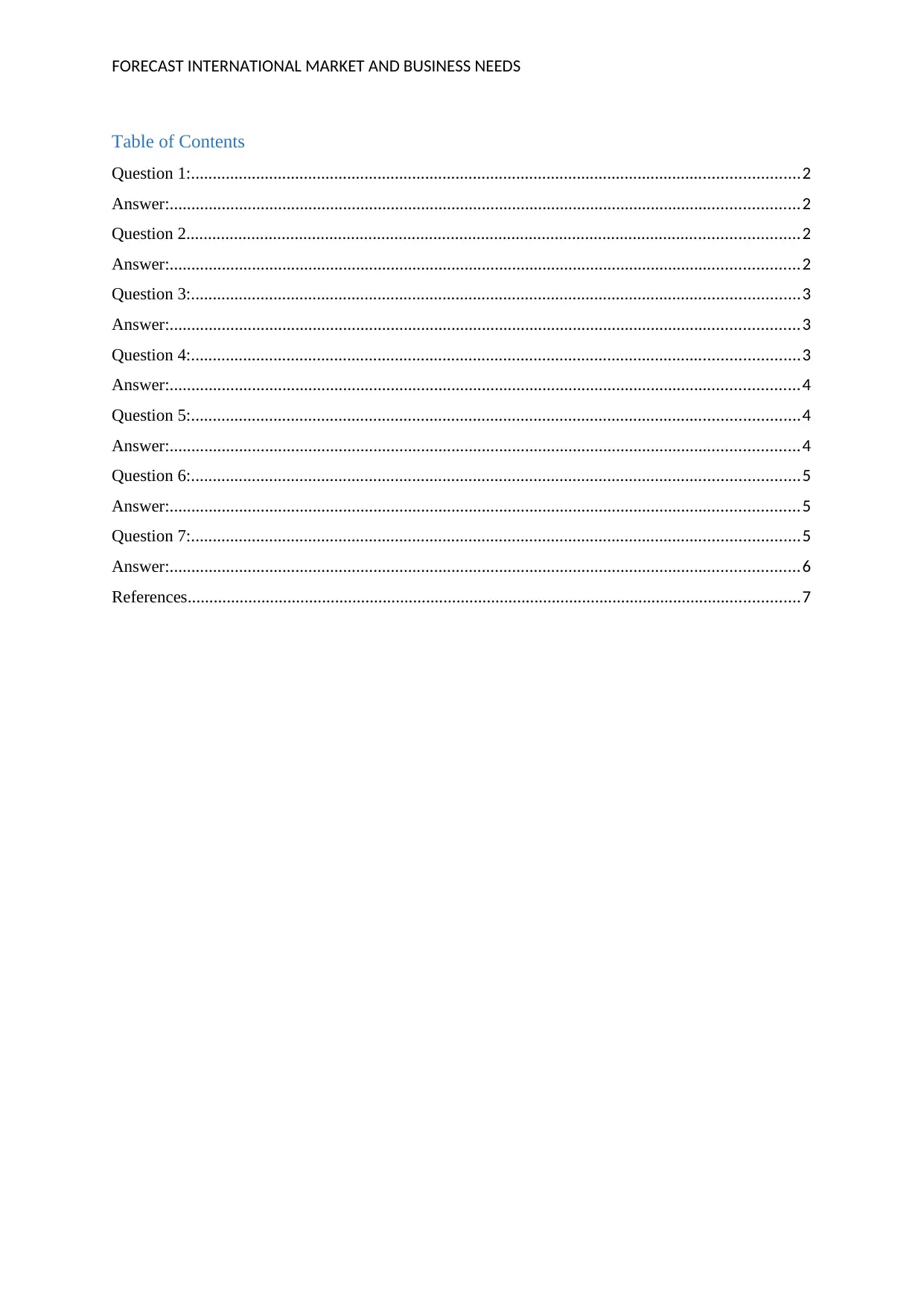
FORECAST INTERNATIONAL MARKET AND BUSINESS NEEDS
Table of Contents
Question 1:............................................................................................................................................2
Answer:.................................................................................................................................................2
Question 2.............................................................................................................................................2
Answer:.................................................................................................................................................2
Question 3:............................................................................................................................................3
Answer:.................................................................................................................................................3
Question 4:............................................................................................................................................3
Answer:.................................................................................................................................................4
Question 5:............................................................................................................................................4
Answer:.................................................................................................................................................4
Question 6:............................................................................................................................................5
Answer:.................................................................................................................................................5
Question 7:............................................................................................................................................5
Answer:.................................................................................................................................................6
References.............................................................................................................................................7
Table of Contents
Question 1:............................................................................................................................................2
Answer:.................................................................................................................................................2
Question 2.............................................................................................................................................2
Answer:.................................................................................................................................................2
Question 3:............................................................................................................................................3
Answer:.................................................................................................................................................3
Question 4:............................................................................................................................................3
Answer:.................................................................................................................................................4
Question 5:............................................................................................................................................4
Answer:.................................................................................................................................................4
Question 6:............................................................................................................................................5
Answer:.................................................................................................................................................5
Question 7:............................................................................................................................................5
Answer:.................................................................................................................................................6
References.............................................................................................................................................7
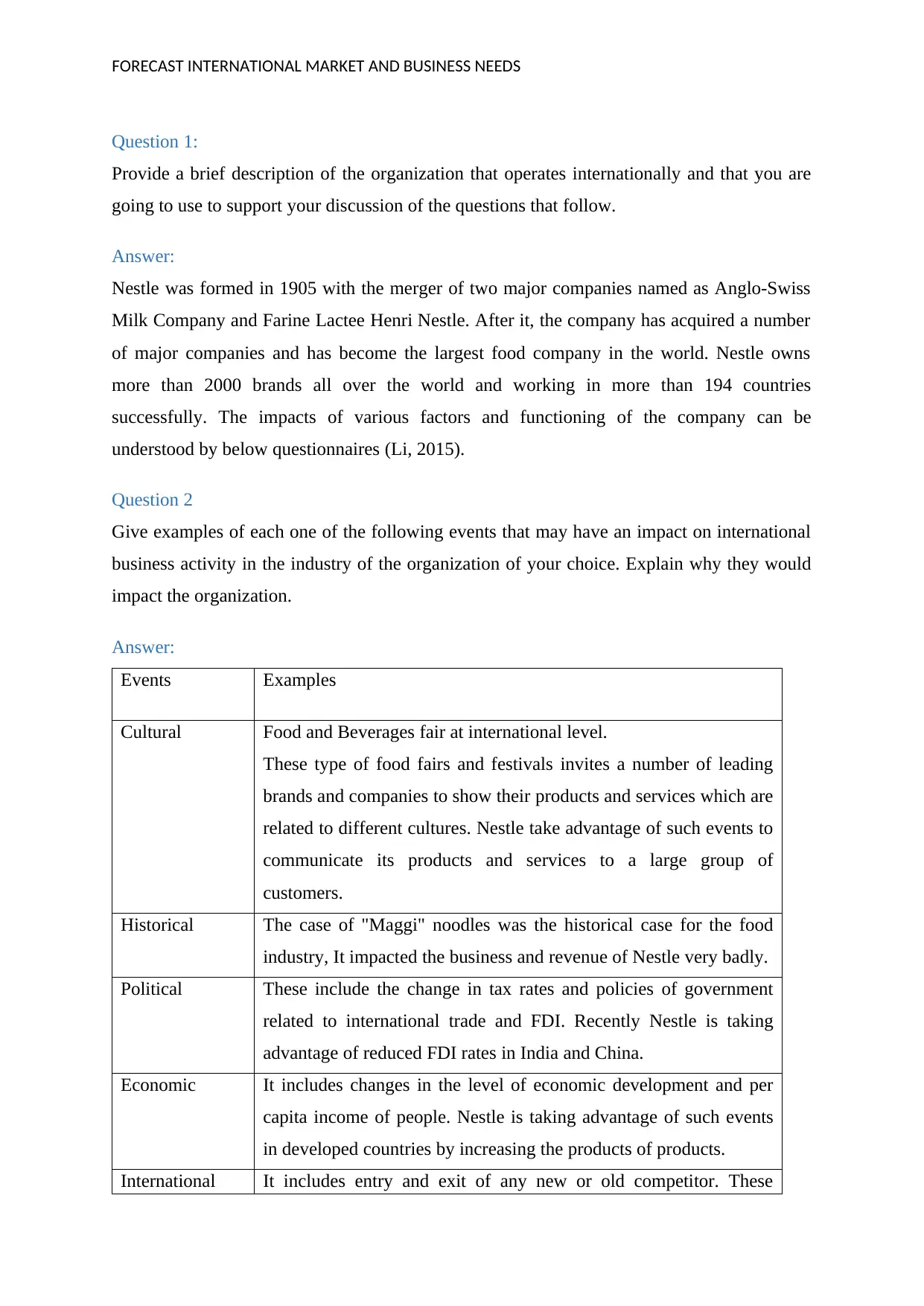
FORECAST INTERNATIONAL MARKET AND BUSINESS NEEDS
Question 1:
Provide a brief description of the organization that operates internationally and that you are
going to use to support your discussion of the questions that follow.
Answer:
Nestle was formed in 1905 with the merger of two major companies named as Anglo-Swiss
Milk Company and Farine Lactee Henri Nestle. After it, the company has acquired a number
of major companies and has become the largest food company in the world. Nestle owns
more than 2000 brands all over the world and working in more than 194 countries
successfully. The impacts of various factors and functioning of the company can be
understood by below questionnaires (Li, 2015).
Question 2
Give examples of each one of the following events that may have an impact on international
business activity in the industry of the organization of your choice. Explain why they would
impact the organization.
Answer:
Events Examples
Cultural Food and Beverages fair at international level.
These type of food fairs and festivals invites a number of leading
brands and companies to show their products and services which are
related to different cultures. Nestle take advantage of such events to
communicate its products and services to a large group of
customers.
Historical The case of "Maggi" noodles was the historical case for the food
industry, It impacted the business and revenue of Nestle very badly.
Political These include the change in tax rates and policies of government
related to international trade and FDI. Recently Nestle is taking
advantage of reduced FDI rates in India and China.
Economic It includes changes in the level of economic development and per
capita income of people. Nestle is taking advantage of such events
in developed countries by increasing the products of products.
International It includes entry and exit of any new or old competitor. These
Question 1:
Provide a brief description of the organization that operates internationally and that you are
going to use to support your discussion of the questions that follow.
Answer:
Nestle was formed in 1905 with the merger of two major companies named as Anglo-Swiss
Milk Company and Farine Lactee Henri Nestle. After it, the company has acquired a number
of major companies and has become the largest food company in the world. Nestle owns
more than 2000 brands all over the world and working in more than 194 countries
successfully. The impacts of various factors and functioning of the company can be
understood by below questionnaires (Li, 2015).
Question 2
Give examples of each one of the following events that may have an impact on international
business activity in the industry of the organization of your choice. Explain why they would
impact the organization.
Answer:
Events Examples
Cultural Food and Beverages fair at international level.
These type of food fairs and festivals invites a number of leading
brands and companies to show their products and services which are
related to different cultures. Nestle take advantage of such events to
communicate its products and services to a large group of
customers.
Historical The case of "Maggi" noodles was the historical case for the food
industry, It impacted the business and revenue of Nestle very badly.
Political These include the change in tax rates and policies of government
related to international trade and FDI. Recently Nestle is taking
advantage of reduced FDI rates in India and China.
Economic It includes changes in the level of economic development and per
capita income of people. Nestle is taking advantage of such events
in developed countries by increasing the products of products.
International It includes entry and exit of any new or old competitor. These
⊘ This is a preview!⊘
Do you want full access?
Subscribe today to unlock all pages.

Trusted by 1+ million students worldwide
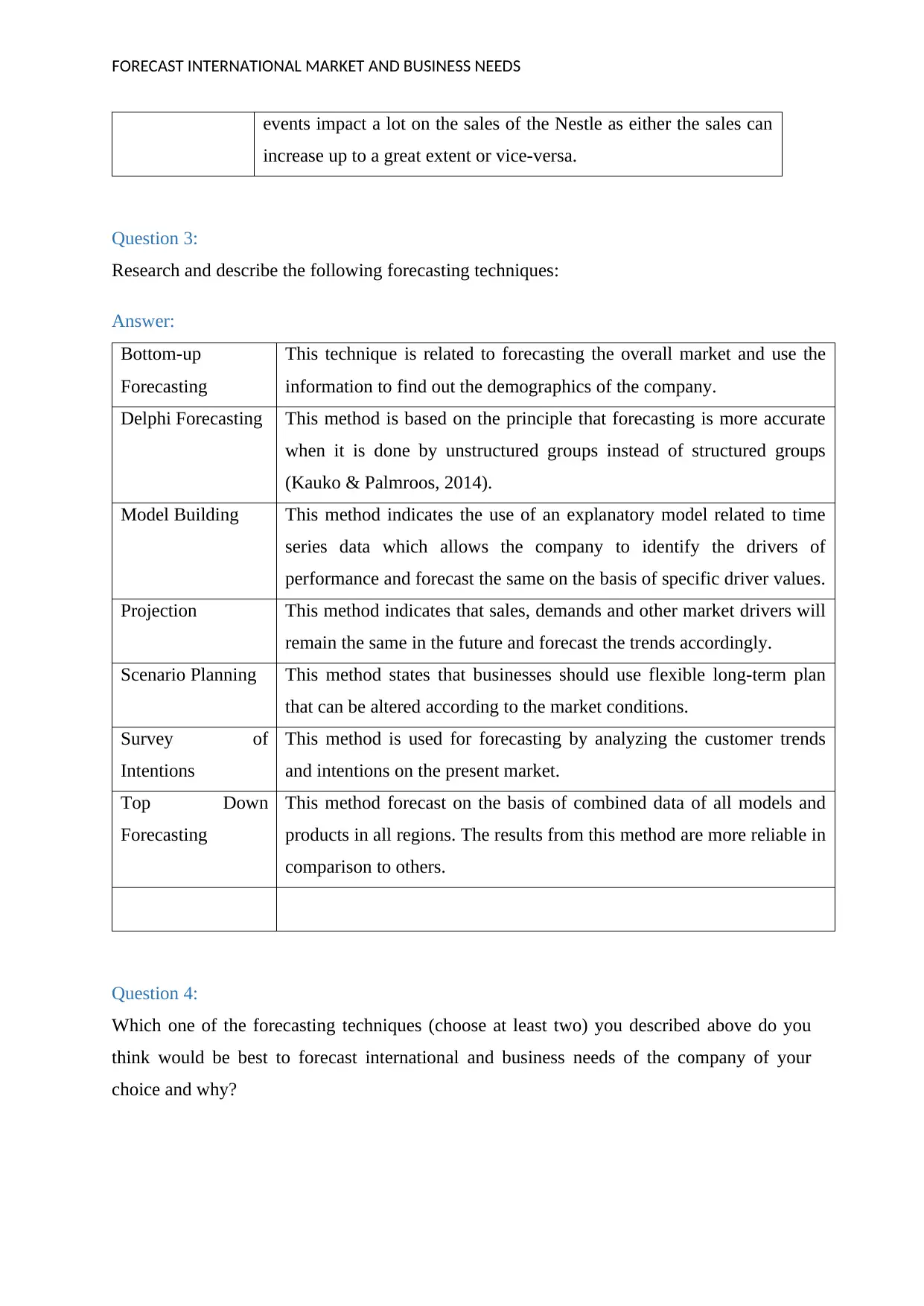
FORECAST INTERNATIONAL MARKET AND BUSINESS NEEDS
events impact a lot on the sales of the Nestle as either the sales can
increase up to a great extent or vice-versa.
Question 3:
Research and describe the following forecasting techniques:
Answer:
Bottom-up
Forecasting
This technique is related to forecasting the overall market and use the
information to find out the demographics of the company.
Delphi Forecasting This method is based on the principle that forecasting is more accurate
when it is done by unstructured groups instead of structured groups
(Kauko & Palmroos, 2014).
Model Building This method indicates the use of an explanatory model related to time
series data which allows the company to identify the drivers of
performance and forecast the same on the basis of specific driver values.
Projection This method indicates that sales, demands and other market drivers will
remain the same in the future and forecast the trends accordingly.
Scenario Planning This method states that businesses should use flexible long-term plan
that can be altered according to the market conditions.
Survey of
Intentions
This method is used for forecasting by analyzing the customer trends
and intentions on the present market.
Top Down
Forecasting
This method forecast on the basis of combined data of all models and
products in all regions. The results from this method are more reliable in
comparison to others.
Question 4:
Which one of the forecasting techniques (choose at least two) you described above do you
think would be best to forecast international and business needs of the company of your
choice and why?
events impact a lot on the sales of the Nestle as either the sales can
increase up to a great extent or vice-versa.
Question 3:
Research and describe the following forecasting techniques:
Answer:
Bottom-up
Forecasting
This technique is related to forecasting the overall market and use the
information to find out the demographics of the company.
Delphi Forecasting This method is based on the principle that forecasting is more accurate
when it is done by unstructured groups instead of structured groups
(Kauko & Palmroos, 2014).
Model Building This method indicates the use of an explanatory model related to time
series data which allows the company to identify the drivers of
performance and forecast the same on the basis of specific driver values.
Projection This method indicates that sales, demands and other market drivers will
remain the same in the future and forecast the trends accordingly.
Scenario Planning This method states that businesses should use flexible long-term plan
that can be altered according to the market conditions.
Survey of
Intentions
This method is used for forecasting by analyzing the customer trends
and intentions on the present market.
Top Down
Forecasting
This method forecast on the basis of combined data of all models and
products in all regions. The results from this method are more reliable in
comparison to others.
Question 4:
Which one of the forecasting techniques (choose at least two) you described above do you
think would be best to forecast international and business needs of the company of your
choice and why?
Paraphrase This Document
Need a fresh take? Get an instant paraphrase of this document with our AI Paraphraser
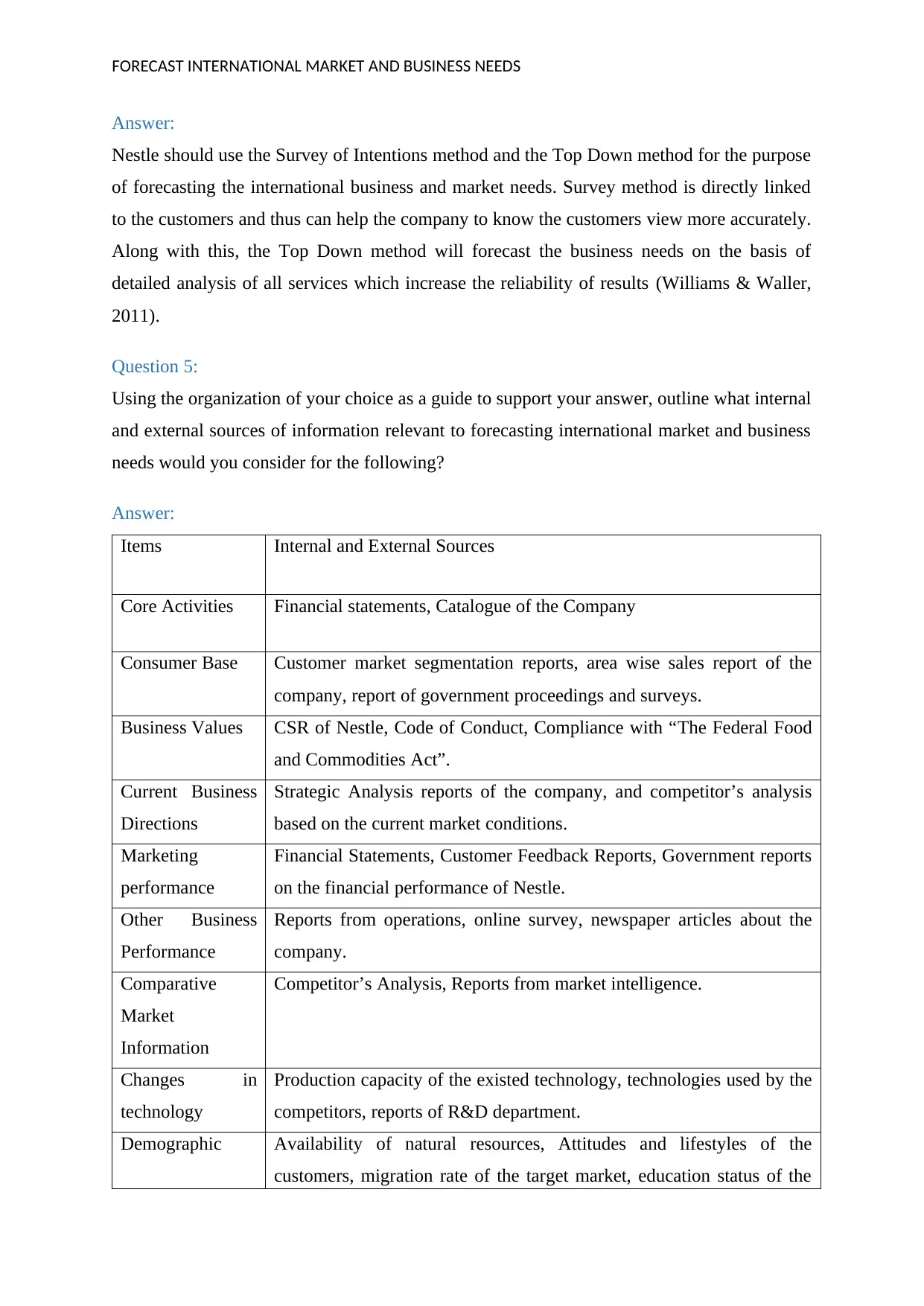
FORECAST INTERNATIONAL MARKET AND BUSINESS NEEDS
Answer:
Nestle should use the Survey of Intentions method and the Top Down method for the purpose
of forecasting the international business and market needs. Survey method is directly linked
to the customers and thus can help the company to know the customers view more accurately.
Along with this, the Top Down method will forecast the business needs on the basis of
detailed analysis of all services which increase the reliability of results (Williams & Waller,
2011).
Question 5:
Using the organization of your choice as a guide to support your answer, outline what internal
and external sources of information relevant to forecasting international market and business
needs would you consider for the following?
Answer:
Items Internal and External Sources
Core Activities Financial statements, Catalogue of the Company
Consumer Base Customer market segmentation reports, area wise sales report of the
company, report of government proceedings and surveys.
Business Values CSR of Nestle, Code of Conduct, Compliance with “The Federal Food
and Commodities Act”.
Current Business
Directions
Strategic Analysis reports of the company, and competitor’s analysis
based on the current market conditions.
Marketing
performance
Financial Statements, Customer Feedback Reports, Government reports
on the financial performance of Nestle.
Other Business
Performance
Reports from operations, online survey, newspaper articles about the
company.
Comparative
Market
Information
Competitor’s Analysis, Reports from market intelligence.
Changes in
technology
Production capacity of the existed technology, technologies used by the
competitors, reports of R&D department.
Demographic Availability of natural resources, Attitudes and lifestyles of the
customers, migration rate of the target market, education status of the
Answer:
Nestle should use the Survey of Intentions method and the Top Down method for the purpose
of forecasting the international business and market needs. Survey method is directly linked
to the customers and thus can help the company to know the customers view more accurately.
Along with this, the Top Down method will forecast the business needs on the basis of
detailed analysis of all services which increase the reliability of results (Williams & Waller,
2011).
Question 5:
Using the organization of your choice as a guide to support your answer, outline what internal
and external sources of information relevant to forecasting international market and business
needs would you consider for the following?
Answer:
Items Internal and External Sources
Core Activities Financial statements, Catalogue of the Company
Consumer Base Customer market segmentation reports, area wise sales report of the
company, report of government proceedings and surveys.
Business Values CSR of Nestle, Code of Conduct, Compliance with “The Federal Food
and Commodities Act”.
Current Business
Directions
Strategic Analysis reports of the company, and competitor’s analysis
based on the current market conditions.
Marketing
performance
Financial Statements, Customer Feedback Reports, Government reports
on the financial performance of Nestle.
Other Business
Performance
Reports from operations, online survey, newspaper articles about the
company.
Comparative
Market
Information
Competitor’s Analysis, Reports from market intelligence.
Changes in
technology
Production capacity of the existed technology, technologies used by the
competitors, reports of R&D department.
Demographic Availability of natural resources, Attitudes and lifestyles of the
customers, migration rate of the target market, education status of the
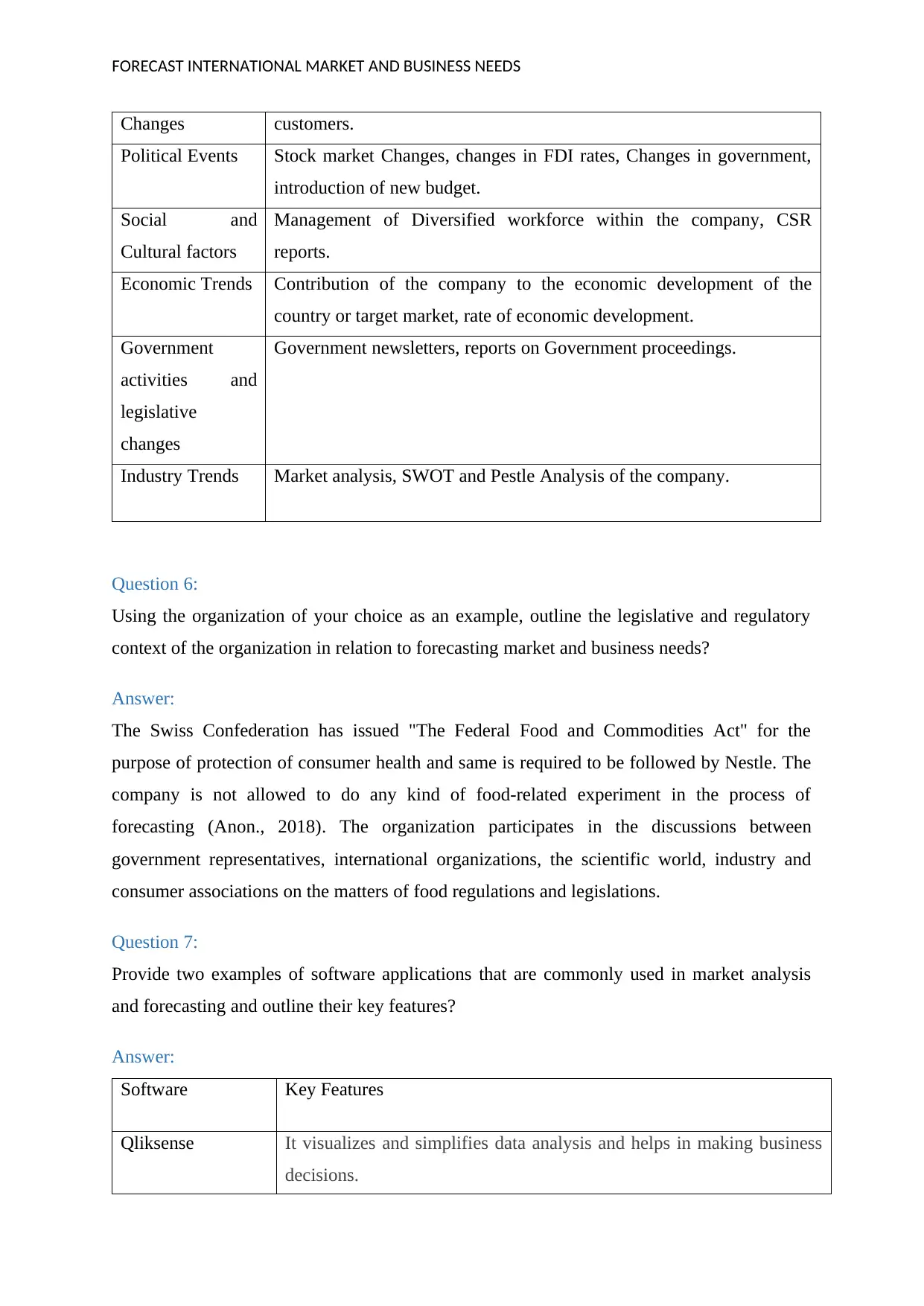
FORECAST INTERNATIONAL MARKET AND BUSINESS NEEDS
Changes customers.
Political Events Stock market Changes, changes in FDI rates, Changes in government,
introduction of new budget.
Social and
Cultural factors
Management of Diversified workforce within the company, CSR
reports.
Economic Trends Contribution of the company to the economic development of the
country or target market, rate of economic development.
Government
activities and
legislative
changes
Government newsletters, reports on Government proceedings.
Industry Trends Market analysis, SWOT and Pestle Analysis of the company.
Question 6:
Using the organization of your choice as an example, outline the legislative and regulatory
context of the organization in relation to forecasting market and business needs?
Answer:
The Swiss Confederation has issued "The Federal Food and Commodities Act" for the
purpose of protection of consumer health and same is required to be followed by Nestle. The
company is not allowed to do any kind of food-related experiment in the process of
forecasting (Anon., 2018). The organization participates in the discussions between
government representatives, international organizations, the scientific world, industry and
consumer associations on the matters of food regulations and legislations.
Question 7:
Provide two examples of software applications that are commonly used in market analysis
and forecasting and outline their key features?
Answer:
Software Key Features
Qliksense It visualizes and simplifies data analysis and helps in making business
decisions.
Changes customers.
Political Events Stock market Changes, changes in FDI rates, Changes in government,
introduction of new budget.
Social and
Cultural factors
Management of Diversified workforce within the company, CSR
reports.
Economic Trends Contribution of the company to the economic development of the
country or target market, rate of economic development.
Government
activities and
legislative
changes
Government newsletters, reports on Government proceedings.
Industry Trends Market analysis, SWOT and Pestle Analysis of the company.
Question 6:
Using the organization of your choice as an example, outline the legislative and regulatory
context of the organization in relation to forecasting market and business needs?
Answer:
The Swiss Confederation has issued "The Federal Food and Commodities Act" for the
purpose of protection of consumer health and same is required to be followed by Nestle. The
company is not allowed to do any kind of food-related experiment in the process of
forecasting (Anon., 2018). The organization participates in the discussions between
government representatives, international organizations, the scientific world, industry and
consumer associations on the matters of food regulations and legislations.
Question 7:
Provide two examples of software applications that are commonly used in market analysis
and forecasting and outline their key features?
Answer:
Software Key Features
Qliksense It visualizes and simplifies data analysis and helps in making business
decisions.
⊘ This is a preview!⊘
Do you want full access?
Subscribe today to unlock all pages.

Trusted by 1+ million students worldwide
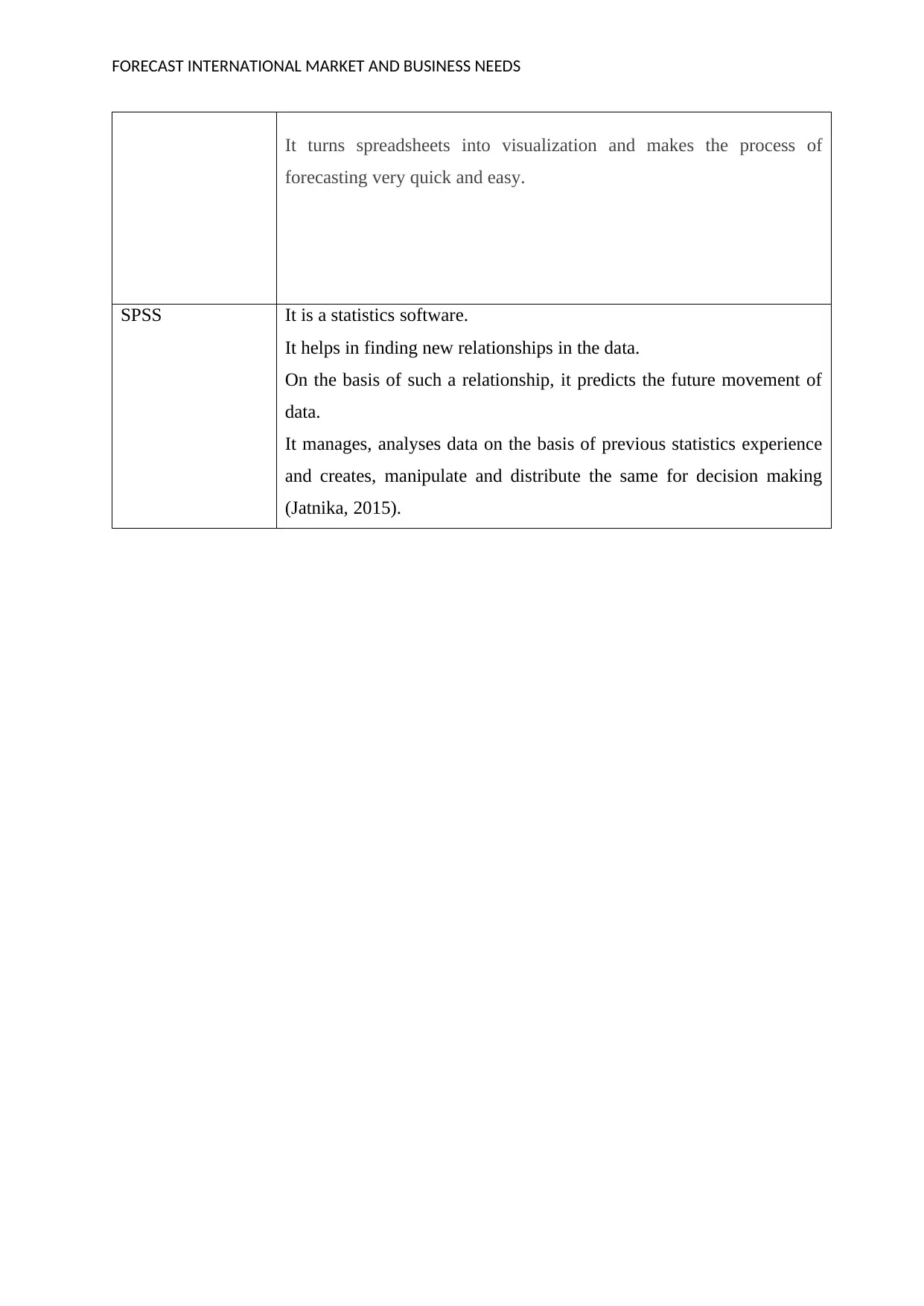
FORECAST INTERNATIONAL MARKET AND BUSINESS NEEDS
It turns spreadsheets into visualization and makes the process of
forecasting very quick and easy.
SPSS It is a statistics software.
It helps in finding new relationships in the data.
On the basis of such a relationship, it predicts the future movement of
data.
It manages, analyses data on the basis of previous statistics experience
and creates, manipulate and distribute the same for decision making
(Jatnika, 2015).
It turns spreadsheets into visualization and makes the process of
forecasting very quick and easy.
SPSS It is a statistics software.
It helps in finding new relationships in the data.
On the basis of such a relationship, it predicts the future movement of
data.
It manages, analyses data on the basis of previous statistics experience
and creates, manipulate and distribute the same for decision making
(Jatnika, 2015).
Paraphrase This Document
Need a fresh take? Get an instant paraphrase of this document with our AI Paraphraser
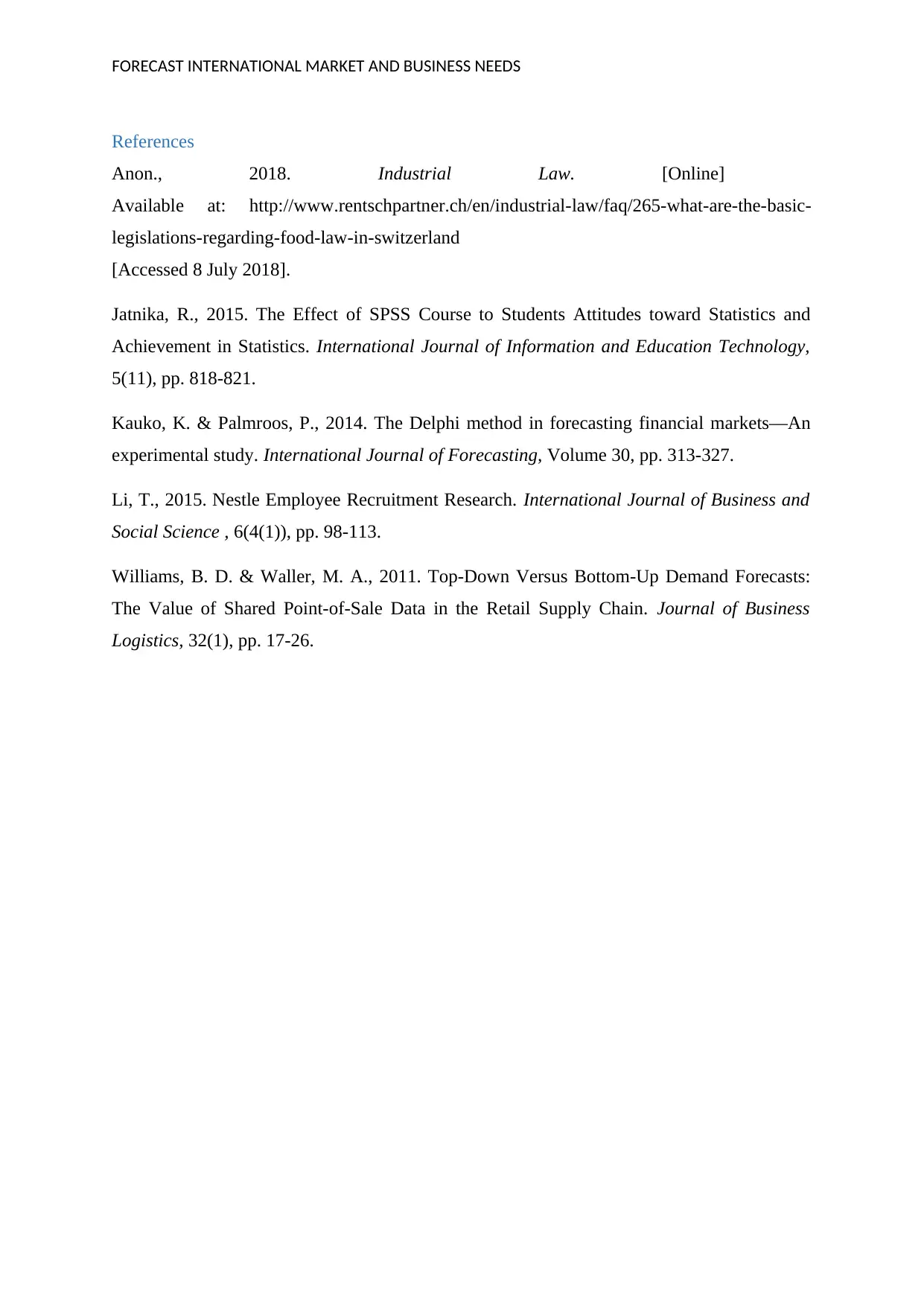
FORECAST INTERNATIONAL MARKET AND BUSINESS NEEDS
References
Anon., 2018. Industrial Law. [Online]
Available at: http://www.rentschpartner.ch/en/industrial-law/faq/265-what-are-the-basic-
legislations-regarding-food-law-in-switzerland
[Accessed 8 July 2018].
Jatnika, R., 2015. The Effect of SPSS Course to Students Attitudes toward Statistics and
Achievement in Statistics. International Journal of Information and Education Technology,
5(11), pp. 818-821.
Kauko, K. & Palmroos, P., 2014. The Delphi method in forecasting financial markets—An
experimental study. International Journal of Forecasting, Volume 30, pp. 313-327.
Li, T., 2015. Nestle Employee Recruitment Research. International Journal of Business and
Social Science , 6(4(1)), pp. 98-113.
Williams, B. D. & Waller, M. A., 2011. Top‐Down Versus Bottom‐Up Demand Forecasts:
The Value of Shared Point‐of‐Sale Data in the Retail Supply Chain. Journal of Business
Logistics, 32(1), pp. 17-26.
References
Anon., 2018. Industrial Law. [Online]
Available at: http://www.rentschpartner.ch/en/industrial-law/faq/265-what-are-the-basic-
legislations-regarding-food-law-in-switzerland
[Accessed 8 July 2018].
Jatnika, R., 2015. The Effect of SPSS Course to Students Attitudes toward Statistics and
Achievement in Statistics. International Journal of Information and Education Technology,
5(11), pp. 818-821.
Kauko, K. & Palmroos, P., 2014. The Delphi method in forecasting financial markets—An
experimental study. International Journal of Forecasting, Volume 30, pp. 313-327.
Li, T., 2015. Nestle Employee Recruitment Research. International Journal of Business and
Social Science , 6(4(1)), pp. 98-113.
Williams, B. D. & Waller, M. A., 2011. Top‐Down Versus Bottom‐Up Demand Forecasts:
The Value of Shared Point‐of‐Sale Data in the Retail Supply Chain. Journal of Business
Logistics, 32(1), pp. 17-26.
1 out of 8
Related Documents
Your All-in-One AI-Powered Toolkit for Academic Success.
+13062052269
info@desklib.com
Available 24*7 on WhatsApp / Email
![[object Object]](/_next/static/media/star-bottom.7253800d.svg)
Unlock your academic potential
Copyright © 2020–2025 A2Z Services. All Rights Reserved. Developed and managed by ZUCOL.





